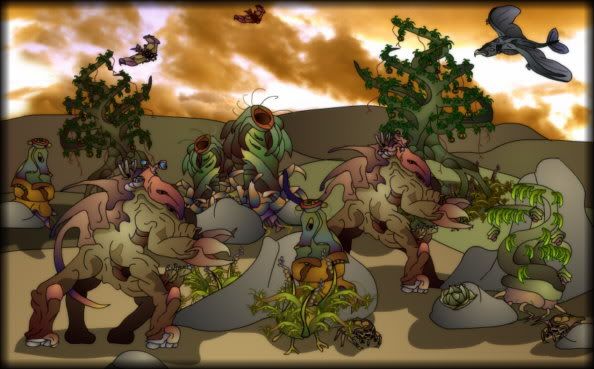S = Struggling due to lack of food sources/ too much competition
I = struggling due to Inefficiency/ requiring more energy than can be gained
E = struggling due to being Eaten too much/ poor defences
T = Thriving
W = very Widespread around the world
C = Confined to a few regions
L = species noted for its Longevity, having lasted many eras
U = unchallenged, at or near the top of its food chain/ no serious predators
*Red* = species did not survive to the end of this era
(nothing) = no major problems / average / nothing notable
Land Animals census: (60 species)
Leafworm (T/W/L), Terradid MrkII (S/E/C/L), Clepsuryte (C/L), LungScraper (E/W), Sandavalion (S/C),
Hiboryte (T/W), Cronodid (C), Mouthvalion (S), Audorix (S/C), Kakoo (S/C),
Longbay Cloudfire (S), Arix (S/C), LandScraper (S/E/W), Hextupler (S), Xiavalion (S/W),
Island Dawnfire (T/W), Mirramid (E/S), Jubblerus Fruitus (S/W), SkullScraper (W), Volaticyte,
Aquaupler (S/E), Armtupler (S), Jubblera Sensica (T/W), Koranthea (S/C), Longbay Fireskimmer (W),
Karakavalion (W/U), Ursulanyte (E/C), Jafankunea (S/C), Diplodupler, Sensorix,
Lithodid (S), Merlyte (T/W), Falcirix (U), Heftupler (T/U), Kanenian,
Dusearm (T), Diggadid (T), Phratrevalion, Uglybug, Slime Finner (E/W),
Fire Raider (W), Groundfire (C), Plutonodupler (C), Spring bug, Trilarm (U),
Pre Legger (T/W), Flevryte (T), Ol Scraper (W), Piedieau (E), Black Aurora (W),
Dwarf Bulgorb (T), Kalavalion (T), Chrontrevalion, Rivervalion (T/W), Knogano (I/U),
Loterokunea (T/C), Saaranix, Mursulanyte (T), Fluteryte (T), Jubblerus Orbus (T/W)
Land Plants census: (30 species)
Lichen (W/L), Proto-Moss (S/W/L), Multiplying Zeeboo (C/L), Big Fanel V3 (W/L), Proto-Tranel (S),
Chungus (T/W/U), Parasitic Moss (T/W), Tougher Zeeboo (C), Attack Tranel (I), Clinging-Tick (W),
Scavenger Fanel (S/E/W), Weak Fern (T/W), Novo Tranel, Woody Fanel (T/W), Sprouty Fern (E/W),
Super Lichen (W), Fire Moss (S/W), Interactive Zeeboo (I/C), Hearty Moss (I/W/U), Sprawling Tranel (T),
Skyward Woodfanel (T/W), Boom Fern (E/W), Leafy Zeeboo (C), Buggy Moss (U), Rock Zeeboo (C/U),
Ground Fuzz (S), Collective Zeeboo (S,C), Fern Tree (E/W), Parasitic Driftseed (W), Sweet Fern (T)
Sea Animals census: (50 species)
Sandworm (W/L), Ponduryte (W/L), Dibbler-Ice 2.0 (S/W/L), Simplavalion (W/L), Cloudfish (S/W/L),
Nitros Intrepidus (W/L), Quintupler (W/L), Socivalion Mrk IV (S), Infil-cult (W), Garbageos Megatronus (S/W),
Redfish (S/W), Resistousis Helifish (W), Sea Tick (W), Xoso Finner (S), Yuckius Prettius (W),
Shellster Kipinus (W), Shy Hunter (W), Double Finner (S/W), Stormfish (T/W), Azure Serpenteel (S/W),
Clamworm (W), Mibbler (W), Giant Quintupler (U), Sea Slug (T/W), Driftworm (T/W), Megafinn (S/E/W),
Crimson Slasheel (W), Koranops (T/W), Amacilndasa (W), Novopredavalion (T/W/U), Harpoon Serpenteel (S),
Geoturyte (E/W), Flatfish (W), Muto-Cult (W), Ol Finner (T/W/U), Milipod (S/E),
Ebiscone (T/W), Golden Imperieel (S/W), Pack Finner (T/W), Yuckius BumpusHuntus (S), Yucky Sea Monster (I/U),
Voidus Garbageos(T/W), Guardian Serpenteel (S), Radarex (T/W), Supercult (I), Shellster Gigantus (W),
Silver Intelieel (W/U), Electrical Serpenteel (W), Globefinn (W/U), Squinops (W), Suxorfish (W)
Sea Plants census (13 species):
Cryoalgae (W/L), Sea Urchin (W/L/U), Algaceae Dendrocovitis (T/L), Bathyscaper (W/L), Spongita Chilled (L),
Bubble Zeeboo (W), Bathystower, Spongita Terranova (T/W), Algaceae Rerethermis (T/W), Sticky Zeeboo (W),
Aguaminaret (T/W), Sea Fuzz (S), Spongita Wangosia (T/W)
 This is your main NES right now too after all...
This is your main NES right now too after all...







 )
)